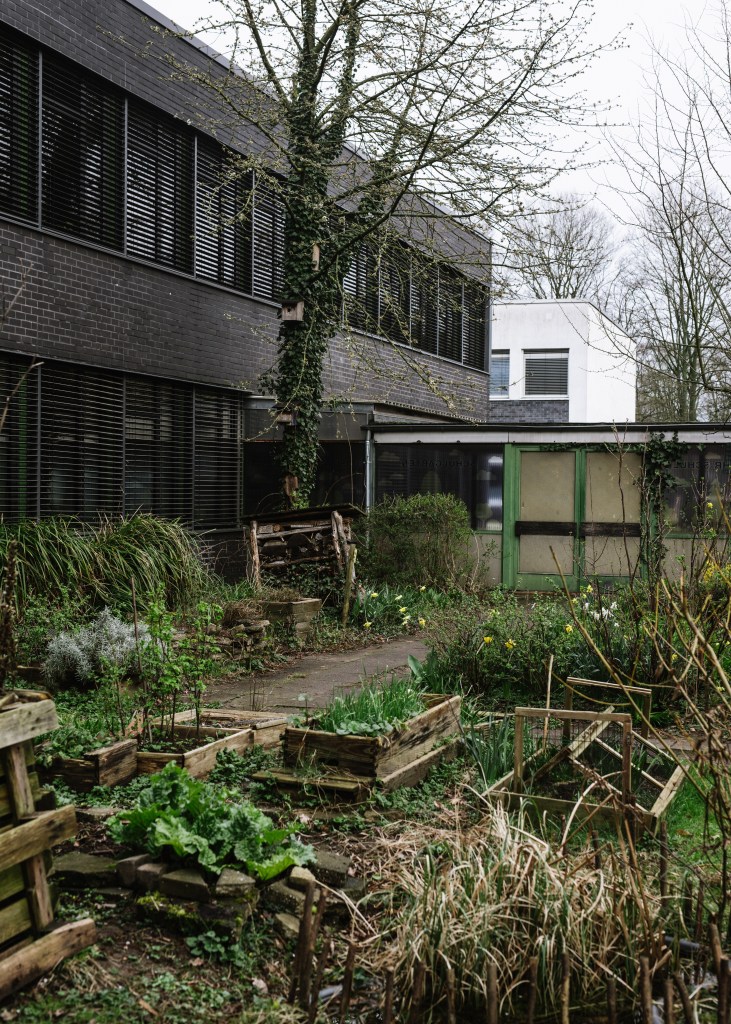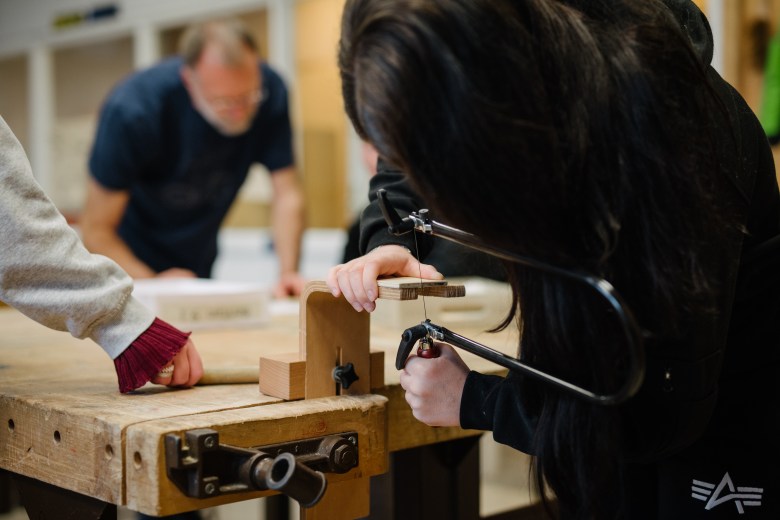COLOGNE, Germany — Neriman Raim, a 16-year-old student in this northwestern German city, thought that after finishing school she’d want to work in an office.

But two years ago, she did a two-week internship in an architect’s bureau, and it was tedious. Later, a placement working with kindergarteners led her to consider a career as a teacher — but not of kids this young. The next school year, she spent three weeks supervising older children as they did their homework.
Neriman now plans to become an educator working with grade-school children. After finishing school this summer, she’ll participate in a year-long placement to confirm that teaching is the right career for her before going to a technical college. Her internships offered a glimpse of what working life could look like, she said: “I could see what a day is like with kids.”

Neriman is taking part in Kein Abschluss ohne Anschluss (KAoA) — or “no graduation without connection” — a program that has been rolled out across the German state of North Rhine-Westphalia to help students better plan for their futures. Young people get support with resumes and job applications; in ninth grade, they participate in short internships with local businesses and have the option of doing a year-long, one-day-a week work placements in grade 10.
“You don’t learn about a job in school,” said Sonja Gryzik, who teaches English, math and career orientation at the school Neriman attends, Ursula Kuhr Schule. “You have to experience it.”
Germany and other Western European countries have long directed students into career paths at earlier ages than in the U.S., often placing kids onto university tracks or vocational education starting at age 10. Students in Germany can embark on apprenticeships directly after finishing general education at age 16 in grade 10, attending vocational schools that offer theoretical study, alongside practical training at a company. College-bound kids stay in school for three more years, ending with an entry exam for university.
The apprenticeship system, which is credited with keeping youth unemployment low, has drawn strong interest in the U.S. amid growing disenchantment with university education. Youth apprenticeships have begun to pop up in several U.S. states, and career exposure programs are expanding. “Many of the best jobs our country has to offer don’t require a college education,” wrote workforce training advocate Ryan Craig in his recent book “Apprentice Nation: How the ‘Earn and Learn’ Alternative to Higher Education Will Create a Stronger and Fairer America.”
But in Germany, the hundreds-year-old vocational system has faced headwinds. There is longstanding criticism that low-income students and those from immigrant backgrounds are channeled into vocational fields and away from more academic ones. More recently, despite the high demand for workers in the trades, students and their parents are increasingly hesitant about vocational education. Germany’s labor market has become digitized, and young people are keeping their options open before settling on a career path. Meanwhile, the pandemic had an outsized impact on vocational training, forcing many programs to close for long periods. And recent immigrants may be unaware of voc-ed’s high standing.

All this has led more students to choose to attend university. Yet many drop out: According to recent data, up to 28 percent of students fail to complete a degree. The figure for students in humanities and natural sciences is even higher, up to 50 percent.
This high failure rate, coupled with labor market needs, has led policymakers to tweak traditional vocational models to make them more flexible. Students in the academic track increasingly have access to both apprenticeships and university, and some students who complete vocational qualifications can still go on to attend a university, where options for combining practical experience with academic studies are growing.
The program Neriman participates in, KAoA, is part of a wave of efforts to engage all students, not just those bound for vocational programs, in workforce preparation. All ninth and 10th grade students in North Rhine-Westphalia must do a three-week-long practical internship. Those on a vocational track begin apprenticeships after completing 10th grade, while students hoping to go to university attend academic high school for three additional years. The program encourages students from all backgrounds to think about their futures in concrete terms, said Bernhard Meyer, a teacher at Ursula Kuhr who coordinates KAoA in 11 towns across the Northwestern region.
“We have every type of possibility,” Meyer said. “And there’s not only apprenticeship or university, there are some studies in between.”
Related: Middle schools are experimenting with themes like math, sustainability and the arts. But is it all just branding?
At Ursula Kuhr Schule, students in the school’s woodworking lab build birdhouses and toy cars. A state-of-the-art kitchen lets students develop their culinary skills. An extensive garden, full of herbs, and boasting a hen house, offers an opportunity to test out horticultural skills.
Students take field trips to learn about different jobs. For example, on a trip to the airport they learn about positions such as flight attendant, fire service, security or aircraft mechanic. Employees from Ford, which has a plant in Cologne, visit the school to talk about their work with students and parents.
While university is free in Germany, students who study vocational fields can achieve financial security earlier on.


Businesses in Germany seem keen to participate in vocational training. Chambers of commerce and industry support company-school partnerships and help smaller businesses train their interns. Students are even represented in unions, said Julian Uehlecke, a representative of the youth wing of Germany’s largest trade union alliance.
The goal of apprenticeships is to offer training in the classroom and in the workplace. The system gives students “a pretty good chance of finding a well-paid stable job,” said Leonard Geyer, a researcher at the European Centre for Social Welfare Policy and Research.
Lukas Graf, head of the Swiss Observatory for Vocational Education and Training described the “basic principle” of Germany’s program as providing all-around training: “in the classroom, in the seminar room, and training in the workplace.”
Mile Glisic, a 15-year-old student at Ursula Kuhr Schule, is doing a long-term work placement at a hardware store and considering an apprenticeship in sales. Earning money while training for a career will help him understand financial planning, and prepare him for a future in which he has a house and family, he said. “I think it’s better because you start to learn what to do with your money when you’re younger,” said Mile.
While the KAoA program has rolled out across all 2,000 schools in this region of Germany, including those that focus on university preparation, Ursula Kuhr Schule prioritizes practical education. Students, more than half of whom come from minority backgrounds, begin career orientation when they are just 12 or 13.
Backers of vocational training say it supports social inclusion by giving young people training that allows them to secure well-paid, stable jobs. But, as in the United States, many argue it limits the prospects of students from marginalized backgrounds and reproduces generational inequalities. This is “a huge debate,” said Graf, of the Swiss Observatory.
To Graf, the value of either a university degree or practical study depends on the particular courses chosen. A university graduate in a field like philosophy, for example, might end up with fewer well-paid opportunities than someone with vocational education training, he said.

The pandemic deepened many parents’ ambivalence about vocational training. While university teaching continued through online platforms, on-the-job training came to a stop when companies had to shut down, said Hubert Ertl, vice president and director of research at Germany’s Federal Institute for Vocational Education and Training and professor of vocational education research at the University of Paderborn.
Parents have a big influence: Research by Ertl’s institute shows that when students express interest in a vocational program, their parents often talk them out of it and push them toward higher ed instead. “That’s often not doing the young people any favors,” he said.
His organization works with schools and parents to tackle preconceived ideas about vocational education. “We’ve started to engage with parents quite directly because parents often don’t know about the vocational programs at all, and they don’t know what opportunities they afford.”
Tim Becker, 20, is doing an IT apprenticeship after completing the university entry exam at his academically oriented high school in Cologne. At first, his parents, who worked for CocaCola, were uneasy. German parents usually want their children to go to university, “especially if they go to a gymnasium,” Becker wrote in an email, referring to academic high schools.
But in school, his career classes urged students to compare the benefits of university to a practical qualification. For Becker, who’d always loved computers, hands-on training beat out academic theory. “I am just not that guy that likes to sit all day in any lectures at some university,” he said. Some of his old classmates have already dropped out of college and are pursuing internships, he added.
Parents at Ursula Kuhr attend meetings, called “future conferences,” with their kids several times a year. Mile’s parents, who moved to Germany from Serbia when he was 9, have met his teachers frequently. “I know that they were very happy with it,” he said, referring to his career path. “They had some questions about it. But I think they’re thinking good about it because, I mean, it’s only doing good for us.”
Neriman’s mother, who is a nanny, “loved the idea” that her daughter would teach in grade-school, Neriman said. The teachers and staff at Ursula Kuhr help students gain confidence about their futures, she said. “The teachers do everything for us — they don’t want anyone to finish school and have nothing.”
Related: The path to a career could start in middle school
Other European countries are seeing similar labor market needs. Denmark, whose minister for education trained as a bricklayer, is facing a significant skills shortage in vocational fields, said Camilla Hutters, head of the National Center for Vocational Education, a Danish research organization.
In the 1960s, practical and project-based learning was common in Danish schools, Hutters said. That changed in the 1990s, when Denmark scored poorly on international rankings like the Program for International Student Assessment. Now, economic needs are causing a swing back to vocational and career education.

Today, Danish students as young as 6 might visit a workplace or spend a week learning about a particular career, she said, and discussions are under way to further integrate practical learning in primary school. Danish leaders also want to improve collaboration with business across the education system, including at the university level, Hutters said, where an increasing number of courses are likely to involve working with a company. Political leaders are discussing reforms that would “improve practical learning in the whole system,” she said.
But a tension between on-the-job training and academia persists in Danish thinking, she added. Although policymakers want to expand the practical element across all levels of education, university still remains the goal for many students and their parents. “This is a little bit of a mixed tendency at the same time, right now in Denmark,” she said.
Back in Germany, Becker will finish his internship in September 2024 with expertise in IT services and network security. Throughout his training, he has earned money — and will get up to €1,260 (roughly $1,360) per month in his final year — which has meant he could avoid taking on part-time work as some of his college friends have done. “You don’t need to sit all day in university and go to work in the evening to pay your bills,” he said.
And it suits him. He grew up surrounded by computers, tinkering alongside his dad, and that love of technology persisted through his teens. He likes working with his hands and doing, “something where I can learn practical things,” he said.
This story about German vocational training was produced by The Hechinger Report, a nonprofit, independent news organization focused on inequality and innovation in education. Sign up for the Hechinger newsletter.



